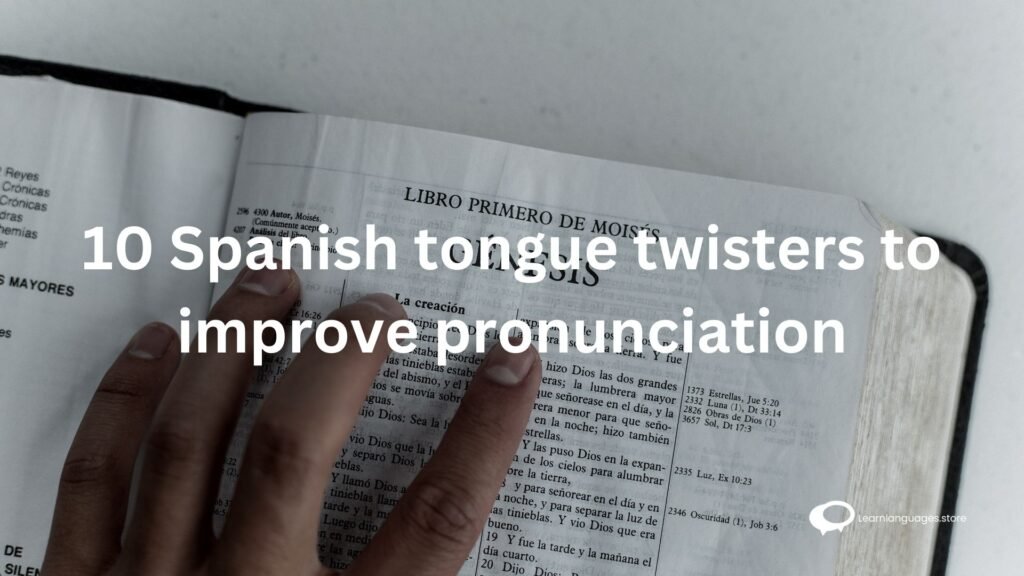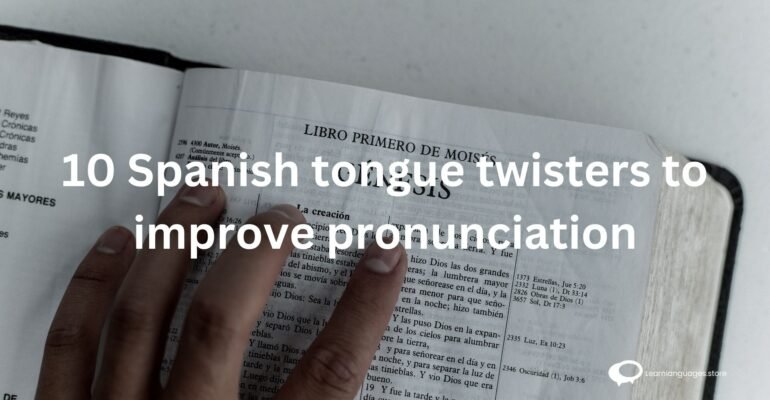10 Spanish Tongue Twisters For Pronunciation
10 Spanish Tongue Twisters For Pronunciation

Use these funny tongue twisters to improve your Spanish pronunciation
Pronunciation is one of the hardest things about learning any language, including Spanish. Even the most careful language learner can change the meaning of a word by mispronouncing it. This can happen with sounds that don’t exist in English, like the rolling r sound, or with words that have tricky vowels.
So, it’s important to start practicing correct pronunciation as soon as you start learning. You will not only teach them how to say words correctly, but native speakers will also be able to understand them better.
Tongue twisters are one of the best and most fun ways to improve your pronunciation in any language. They combine the most difficult sounds into one sentence. The more you say the sentence, the faster and more clearly you’ll be able to say it.
We’ve put together a list of tongue twisters, or strangulates, that focus on different letters and sounds to help you learn how to speak Spanish. Try these out to see how well you can say these words.
Lado, ledo, lido, lodo, ludo, decirlo al revés lo dudo. Ludo, lodo, lido, ledo, lado, ¡Qué trabajo me ha costado!
Translation: Lado, ledo, lido, lodo, ludo, I doubt I can say it in reverse. It’s hard work to play ludo, lodo, lido, ledo, or lada.
The vowels are one part of Spanish pronunciation that is easy to understand. Most of the time, each vowel in Spanish only makes one sound. You’ll be able to say them easily in no time if you practice saying them in this sentence.

Cuando cuentes cuentos, cuenta cuantos cuentos cuentas. Porque si no cuentas cuantos cuentos cuentas, nunca sabrás cuantos cuentos cuentas.
Translation : When you tell a story, keep track of how many stories you tell. Because you’ll never know how many stories you tell if you don’t keep track of them.
Here’s another one to help you practice your vowels. This one shows how much a vowel can change the meaning of a word and how important it is to say each one clearly.
Top 5 movies that can help you to learn spanish
Cómo quieres que te quiera si quien quiero que me quiera no me quiere como quiero que me quiera?
How can I love you if the people you want to love you don’t love you the way you want them to?
This one has a rolling r and a strong qu sound, as well as different vowel sounds. Native speakers will be very impressed if you can say this one quickly.
Ñoño Yáñez come ñame en las mañanas con el niño
The boy and oo Yáez eat yams together in the morning.
The sound doesn’t exist in English, so it can be hard for English speakers to say it right in different words. Don’t worry, this trabalengua is a great way to work on it.

Erre con erre guitarra, erre con erre barril. Rápido corren los carros, cargados de azúcar del ferrocarril
R and r guitar, r and r barrel. Wagons full of sugar from the train are moving quickly.
It’s hard enough for English speakers to get the rolling r sound right, but it’s even harder to get it right in different words. This tongue twister is hard to say, but it will help you get better at making this hard sound.
Tres tristes tigres tragaban trigo en un trigal. Un tigre, dos tigres, tres tigres tragaban en un trigal. ¿Cuál tigre tragaba más? Todos tragaban igual.
Translation: In a field, three sad tigers were eating wheat. Tigers were eating in a wheat field. There was one tiger, two tigers, and three tigers. Who ate the most? Everyone ate the same thing.
Here is another one with the rolling r sound. Because the t sound is so strong, it can be hard to roll the r sound right after it. If you say this tongue twister out loud a few times, you’ll get used to this hard sound.
Un burro comía berros y el perro se los robó. El burro lanzó un rebuzno y el perro al barro cayó.
Translation: The dog took some watercress from a donkey who was eating them. The dog fell into the mud when the donkey made a loud noise.
This trabalengua will help you say different vowel sounds together while rolling the r. (The story is also pretty funny!)

Pedro Pérez Pereira, pobre pintor portugués, pinta pinturas por poca plata, para pasear por Portugal.
Translation: Pedro Pérez Pereira is a poor painter from Portugal. He paints for little money so he can walk around Portugal.
This one is helpful because it helps you find a rhythm when you speak. There is also another variation of this Spanish pronunciation : Pedro Pérez Pereira, pobre pintor portugués, pinta preciosos paisajes por poco precio para poder pasar por París. Pedro Peréz Pereira is a painter who has a lot on his plate.

Si tu gusto no gusta con el gusto que gusta mi gusto, qué disgusto tiene mi gusto al sabre que tu gusto no gusta con el gusto que gusta mi gusto.
Translation:If your taste doesn’t like the taste that I like, it makes my taste sick to know that your taste doesn’t like the taste that I like.
This is another trabalengua with a rhythmic beat. It’s a good way to learn how to translate, too. Try to figure out which words are nouns and which are verbs for a little extra challenge.
El anillo del llavero no tiene llaves. ¿Quién se ha llevado las llaves del anillo del llavero?
Translation: There are no keys on the keyring. Who removed the keys from the keyring?
The last tongue twister on this list helps you get better at making the ll sound, which is hard for many English speakers to say. In fact, this tricky phrase is hard to say even for people who speak Spanish as their first language.
Conclusion
Practice, practise, practise is the only way to improve your speech. This list of tongue twisters is a great way to practise some of the hardest sounds in Spanish. Once you’ve gotten good at these, you’ll be able to speak more clearly. Also, it will be easier for people who speak your language to understand you.
If you’re curious about Spanish language classes, go here.
Get some lessons and learn Spanish.
Learn Languages Store
Vashi,
Email: services@learnlanguages.store










